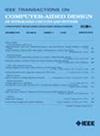利用高斯过程回归估算集成电路年龄的非侵入式方法
IF 2.7
3区 计算机科学
Q2 COMPUTER SCIENCE, HARDWARE & ARCHITECTURE
IEEE Transactions on Computer-Aided Design of Integrated Circuits and Systems
Pub Date : 2024-11-14
DOI:10.1109/TCAD.2024.3499893
引用次数: 0
摘要
集成电路(IC)的老化预测对于制定预防和缓解措施以避免现场出现意外电路故障至关重要。任何电子系统都将受益于精确的老化计算。此外,它还有助于减少电子废弃物的数量和实现绿色计算。在本文中,我们提出了一种利用高斯过程回归(GPR)估算集成电路年龄的方法。环形振荡器(RO)的输出频率受多种因素的影响,包括可跟踪路径、电压、温度和老化。在 GPR 模型训练中利用了这些相关性。我们利用 Synopsys HSPICE 工具、32 纳米预测技术模型 (PTM) 和 Synopsys 技术库演示了环形振荡器的频率衰减。我们使用 0 °C 至 100 °C 的温度变化和 0.80 至 1.05 V 的电压变化来采集数据。我们的方法能精确预测年龄;在线性采样率上,13 级 RO 和 21 级 RO 一个月偏差的最低预测准确率分别为 85.36% 和 87.09%,与最先进的方法(SOTA)相比,预测准确率的提高幅度为 9.74% 至 16.99%。同样,在对数采样率上,13 级 RO 和 21 级 RO 的预测准确率分别为 98.62% 和 98.56%。就预测准确率和年龄预测偏差而言,建议的方法比 SOTA 方法更准确。本文章由计算机程序翻译,如有差异,请以英文原文为准。
Noninvasive Methodology for the Age Estimation of ICs Using Gaussian Process Regression
Age prediction for integrated circuits (ICs) is essential in establishing prevention and mitigation steps to avoid unexpected circuit failures in the field. Any electronic system would get benefit from an accurate age calculation. Additionally, it would assist in reducing the amount of electronic waste and the effort toward green computing. In this article, we propose a methodology to estimate the age of ICs using the Gaussian process regression (GPR). The output frequency of the ring oscillator (RO) is influenced by various factors, including the trackable path, voltage, temperature, and ageing. These dependencies are leveraged in the GPR model training. We demonstrate the RO’s frequency degradation by employing the Synopsys HSPICE tool with 32 nm predictive technology model (PTM) and the Synopsys technology library. We used temperature variation from 0 °C to 100 °C and voltage variation from 0.80 to 1.05 V for the data acquisition. Our methodology predicts age precisely; the minimum prediction accuracy with a month deviation on linear sampling rate is 85.36% for 13-Stage RO and 87.09% for 21-Stage RO, with a range of improvement in prediction accuracy compared to state-of-the-art (SOTA) is 9.74% to 16.99%. Similarly, on the logarithmic sampling rate, the prediction accuracy for 13-Stage RO and 21-Stage RO are 98.62% and 98.56%, respectively. The proposed methodology performs more accurately in terms of prediction accuracy and age prediction deviation from the SOTA methodology.
求助全文
通过发布文献求助,成功后即可免费获取论文全文。
去求助
来源期刊
CiteScore
5.60
自引率
13.80%
发文量
500
审稿时长
7 months
期刊介绍:
The purpose of this Transactions is to publish papers of interest to individuals in the area of computer-aided design of integrated circuits and systems composed of analog, digital, mixed-signal, optical, or microwave components. The aids include methods, models, algorithms, and man-machine interfaces for system-level, physical and logical design including: planning, synthesis, partitioning, modeling, simulation, layout, verification, testing, hardware-software co-design and documentation of integrated circuit and system designs of all complexities. Design tools and techniques for evaluating and designing integrated circuits and systems for metrics such as performance, power, reliability, testability, and security are a focus.

 求助内容:
求助内容: 应助结果提醒方式:
应助结果提醒方式:


